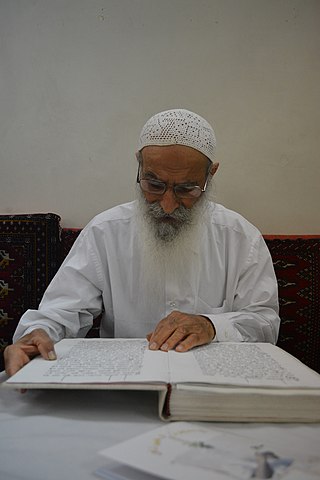
The Ginza Rabba, Ginza Rba, or Sidra Rabba, and formerly the Codex Nasaraeus, is the longest and the most important holy scripture of Mandaeism.
In Mandaeism, ṣauma is a term that means fasting. Although ṣauma can refer to physical fasting, it is more often used in Mandaeism to refer to spiritual piety and abstaining from sin.
In Mandaeism, the World of Light or Lightworld is the primeval, transcendental world from which Tibil and the World of Darkness emerged.

The Left Ginza is one of the two parts of the Ginza Rabba, the longest and the most important holy scripture of Mandaeism. The other part of the Ginza Rabba is the Right Ginza.
In Mandaeism, ʿUr is the king of the World of Darkness or underworld. He is the son of Ruha, the queen of the underworld, and her brother Gaf, one of the giants in the World of Darkness described in book 5 of the Ginza Rabba. Ur is typically portrayed as a large, ferocious dragon or snake. He is represented by the image of a serpent on the skandola talisman.
Mandaean cosmology is the Gnostic conception of the universe in the religion of Mandaeism.
In Mandaeism, Manda d-Hayyi or Manda ḏ-Hiia is an uthra sent by the Great Life as a messenger to John the Baptist. Manda d-Hayyi is considered to be the most important uthra, since he is the one bringing manda to Earth (Tibil).
In Mandaeism, Hayyi Rabbi, 'The Great Living God', is the supreme God from which all things emanate.
The Mandaean calendar is a 365-day solar calendar used by the Mandaean people. It consists of twelve 30-day months, with five extra days at the end of Šumbulta. The Parwanaya festival takes place during those five days. There is no leap year therefore every four years all Mandaean dates move one day back with respect to the Gregorian calendar.

The masiqta is a mass or ritual practiced in the Mandaean religion in order to help guide the soul (nišimta) towards the World of Light in Mandaean cosmology. They are typically performed as funerary rites for Mandaeans who have just died. Although usually translated as "death mass", a few types of masiqta are also performed for living people, such as when priests are ordained. Masiqtas are also used to consecrate houses of worship.
In Mandaeism, the World of Darkness is the underworld located below Tibil (Earth). It is ruled by its king Ur the Leviathan and its queen Ruha, mother of the seven planets and twelve constellations.
Dinanukht is a mythological character in the Ginza Rabba, one of the main religious scriptures of Mandaeism, who is portrayed as an anthropomorphic book. Book 6 of the Right Ginza describes his ascension to the World of Light.
In Mandaean cosmology, Piriawis, also known as the Yardna Rabba, is the sacred life-giving river (yardna) of the World of Light. It is the heavenly counterpart of rivers on Earth (Tibil), which are considered by Mandaeans to be manifestations of the heavenly Piriawis.
The Feast of the Great Shishlam or Dehwa d-Šišlam Rabba or Nauruz Zūṭa is a Mandaean religious holiday that takes place on the 6th and 7th days of Daula, the first month of the Mandaean calendar. It is named after Shishlam, the Mandaean personification of the prototypical priest.

In Mandaeism, a yardna or yardena is a body of flowing fresh water that is suitable for ritual use as baptismal water. The masbuta and other Mandaean rituals such as the tamasha can only be performed in a yardna. Stagnant fresh water, brackish water, and seawater are not considered to be yardnas.
In the Mandaean calendar, Dehwa Hanina or Dehwa Ṭurma, the Little Feast, is celebrated on the 18th day of Taura, which is the 4th month of the Mandaean calendar that corresponds to the Hebrew month Iyar.
Daula, alternatively known as Šabaṭ, is the first month of the Mandaean calendar. The month begins with Dehwa Rabba, or New Year's Day. The Feast of the Great Shishlam is celebrated on the sixth day of the month.
Taura, alternatively known as Ayar, is the fourth month of the Mandaean calendar.
Gadia, alternatively known as Ṭabit, is the twelfth month of the Mandaean calendar.
The following outline is provided as an overview of and topical guide to Mandaeism.






